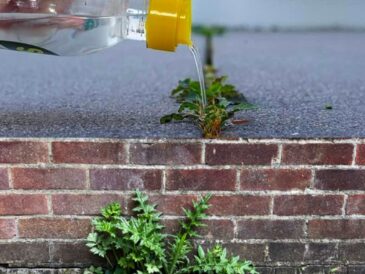✅ Step 1: Prune and Isolate Infected Plants
Cut off all infected parts of the plant. Dispose of the leaves far from your garden to prevent further spread. If the whole plant is covered, isolate it.
✅ Step 2: Apply Homemade Baking Soda Spray
This is the core of the remedy. Here’s the recipe:
Baking Soda Spray Recipe:
- 1 tbsp baking soda
- 1 tsp mild liquid soap (like Castile)
- 1 gallon water
Spray the mixture on all surfaces of the plant every 3 days. Baking soda creates an alkaline environment where fungus can’t survive.
✅ Step 3: Improve Air Circulation and Sunlight
- Space out your plants
- Trim nearby shrubs
- Ensure 4-6 hours of sunlight
This reduces the damp environment mildew thrives in.
✅ Step 4: Use Neem Oil as a Follow-Up Treatment
Neem oil is both antifungal and insecticidal. Apply it once a week after the baking soda sprays to kill remaining spores and prevent new growth
🌸 Additional Remedies Gardeners Swear By
🥛 Milk Spray Solution
Milk contains proteins that help fight mildew.
Recipe:
- 1 part milk
- 2 parts water
Spray every 3–4 days. Works well on zucchini, squash, and cucumbers.
💧 Hydrogen Peroxide Mist
A strong oxidizer, great for stopping spores.
Mix:
- 4 tbsp 3% hydrogen peroxide
- 1 quart water
Mist plants lightly once every 5–7 days.
🧄 Garlic Fungicide Spray
Garlic is a natural antifungal and immune booster.
Recipe:
- Crush 2 garlic cloves
- Boil in 2 cups of water
- Strain and spray when cool
🛡️ Preventive Measures for Long-Term Control
To avoid recurring outbreaks:
- Avoid overhead watering
- Use mulch to reduce splashes
- Choose resistant plant varieties
- Apply compost tea monthly to boost immunity
🌻 Plants Most Affected by Powdery Mildew
Some plants are more susceptible than others:
- Roses
- Zucchini and squash
- Cucumbers
- Peas
- Grapes
- Lilacs
Keep a closer eye on these varieties, especially during warm, humid months.
⚖️ Organic vs Chemical Fungicides: Which Is Better?
| Feature | Organic Remedies | Chemical Fungicides |
|---|---|---|
| Safety for food | ✅ Safe | ❌ Often unsafe for edibles |
| Long-term use | ✅ No resistance buildup | ❌ Resistance can form |
| Cost | ✅ Inexpensive | ❌ Can be costly |
| Eco-impact | ✅ Environmentally friendly | ❌ May harm pollinators |
Conclusion: Organic remedies win for backyard gardeners.
❓ FAQs About Powdery Mildew
1. Can I eat vegetables with powdery mildew?
It’s not toxic, but mildew affects flavor and quality. Remove affected parts and treat the plant.
2. How fast does powdery mildew spread?
It can spread within days, especially in humid conditions. Act fast.
3. Will vinegar kill powdery mildew?
Diluted vinegar can work, but may harm sensitive plants. Use with caution.
4. Does baking soda prevent mildew too?
Yes, it can prevent and treat if used regularly.
5. Can powdery mildew kill my plants?
Yes, if left untreated, it can lead to leaf loss, stunted growth, and death in extreme cases.
6. Is powdery mildew airborne?
Yes, the spores travel by air, which makes it highly contagious among plants.
✅ Conclusion
Powdery mildew is a persistent problem, but it doesn’t have to ruin your garden. With a consistent 2-week treatment plan—including pruning, natural sprays, and environmental adjustments—you can eliminate it naturally and effectively.
Don’t rely solely on chemical products. Your garden deserves a gentle, eco-friendly approach that actually works.




